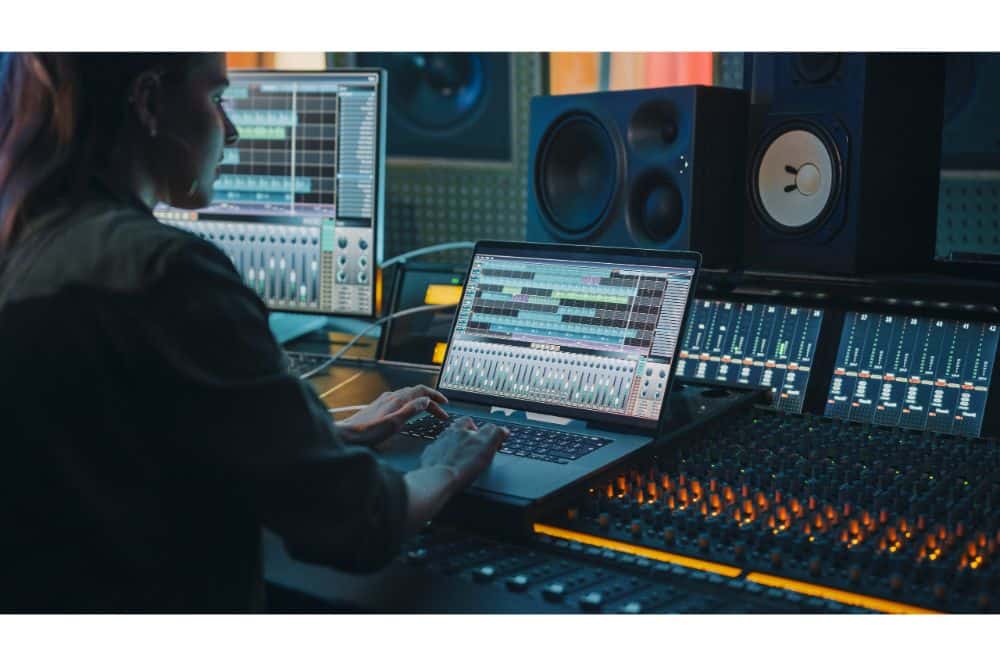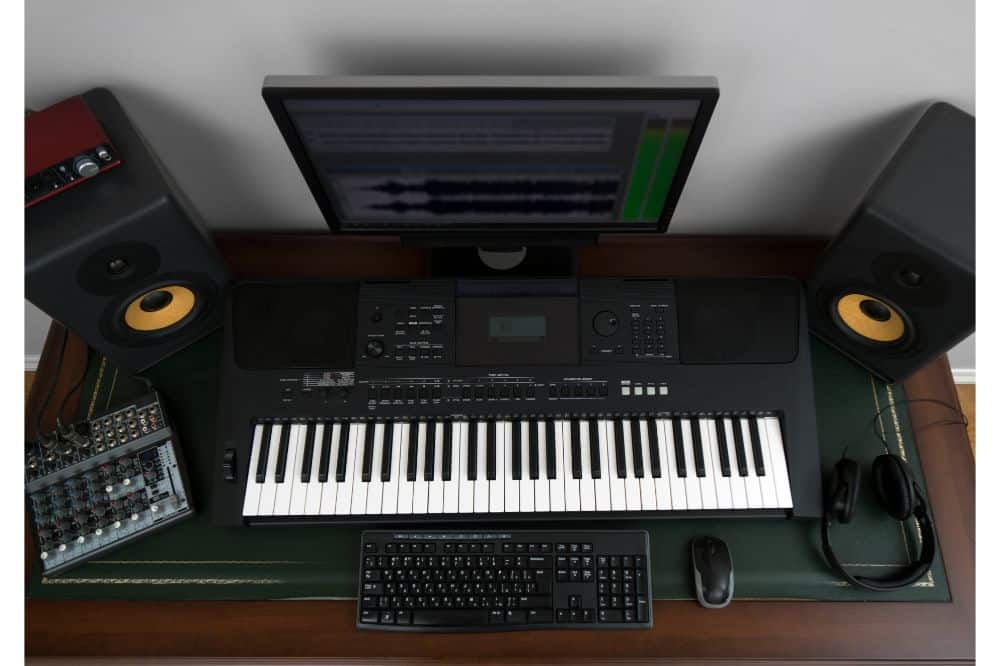Audio production systems continue to become increasingly sophisticated as audio technology innovations keep turning up at a staggeringly fast pace.
Suppose you’re an aspiring audiophile still learning the ropes of studio-quality production. You have access to different component types but don’t have the technical prowess for studio-grade arrangements. Like any other audiophile, you constantly search for ways to improve your sound.
If you want to learn how to connect powered speakers to mixers, you’ve come to the right place. We’ll discuss how mixers differ from preamps and tell you about the connections you can use for powered speakers.
How a Sound System Works
Before we get to the details of how to connect powered speakers to mixers, you must first understand how a traditional sound system works.
Powered speakers and mixers are but mere components of an audio system. Of course, your mixer needs something to work on before your powered speakers can produce audio outputs.
Here are the components of a sound system in the correct order of signal flow:
1. Signal Source Components
Source components are any piece of equipment that provides the audio signals for your sound system to produce. It can be a computer, an MP3 player, a musical instrument, a smartphone, or a tablet.
Musical instruments include microphones that record and transmit inputs from human voices or non-electronic musical instruments.
Without a source, your sound system will not have something to work on, meaning it should be at the beginning of the sound chain.
2. Audio Mixer
The signals from your source or sources will then travel through cables to a mixer.
Mixers, also called sound mixers, sound consoles, or sound desks, serve as an audio system’s control booth. With it, you can change the volume of various speakers and alter a sound’s tonal quality, timbre, and dynamics.
A typical sound mixer has all the knobs, sliders, channel buttons, equalizer controls, and lights necessary for controlling or altering sound signals of various frequencies. While some mixers only have a few channels for a few sound sources, others are pretty complicated, having dozens if not hundreds of channels.
Sound mixers can be analog, digital, or both. They can also have built-in power amplifiers, making them powered mixers.
3. Sound Monitor
Sound monitors are a bit of an extra. An audio system can function without them, and they are typically more important for streamlining various signals from multiple sources.
A sound monitor helps musicians or stage performers here themselves.
You can control monitors directly from your main sound mixer or use a dedicated mixer for them.

4. System Crossover and Amplification
After the sound mixer has done all its work, it delivers all processed signals either to the system crossover or to the amplifier.
The system crossover splits signals into different frequencies, whereas the power amp intensifies the signals for better sound quality.
Which comes first depends on what type of speakers you use – active or passive. We’ll elaborate more on this as we discuss powered speakers.
5. Speakers
Speakers are at the end of every sound chain. They are the most recognizable component of an audio system.
The system only works on signals from the sound source to crossover and amplification. It is a pair of speakers that is responsible for converting those signals into acoustic energy, which is what we call sound.
Speakers come in different forms, sizes, and audio frequency subset handling capabilities.
Preamplifiers Vs. Mixers
For a traditional sound system, a sound source connects to a preamplifier before releasing signals to a passive or active setup. In more complicated arrangements, however, systems use a mixer in the place of the preamp.
What Is a Preamp?
A preamplifier is a device that converts weak sound signals into stronger, noise-tolerant signals for further processing or transmission to a power amplifier. It boosts the weak signals to line-level signals that a power amplifier can process.
Without preamplification, the final output signal may turn out distorted or noisy.
The number of sound signal sources you can connect to a preamp depends on its available ports. While some preamps only have a single input port, others can have more.
How Is a Mixer Different?
Unlike a preamp, a mixer can combine and segregate different audio signals from various sources. In addition, it can add effects to the input signals depending on its features.
Many sound experts will tell you that you need both a preamp and a mixer. However, many modern mixers already have a preamp or several preamps built into their system.
Nevertheless, having an additional preamp can help you improve the quality of your sound and boost its signal more than your mixer allows.
What Are Powered Speakers?
Powered speakers are audio components with a power amplifier built into the speaker enclosure.
Whenever you browse online shopping for powered speakers, you’ll also come across terms like active speakers, passive speakers, and unpowered speakers.
You will see all four types used in sound systems. Notice how the term “powered” is often used in place of “active,” whereas “unpowered” is commonly interchangeable with “passive.”
We can tell you that all unpowered speakers are passive models, and all active models are powered speakers. However, not all powered speakers are active models, and not all passive models are unpowered.
Powered speakers can either be active or passive, depending on how it amplifies a sound signal from a preamp or a mixer.
Active Powered Speaker
An active speaker uses an active crossover filter network. This system crossover receives the signals from a preamp or mixer, splits them, and delivers them separately to individual power amplification before going to the drivers.
In short, the crossover or splitting of signals occurs before amplification.
Passive Powered Speaker
On the other hand, in passive speaker boxes, the crossover occurs after amplification. The speaker receives the signals from a preamp or mixer, uses its built-in power amplifier to increase the signal, and delivers it to the crossover.
How to Connect Powered Speakers to Mixer
Now that you can determine what type of powered speakers you have, it’s also crucial to know whether you can connect them to a mixer. It all falls on what kind of sound mixer you have and what types of connections it allows.
The Problem with Powered Mixers
Suppose you have a powered mixer, that is, a mixer with a built-in amplifier. If you find speaker jacks on your mixer labeled “Speaker Out,” these jacks are intended only for unpowered passive speakers. A Speaker Out signal carries both processed audio signals and electrical power to drive the passive speakers.
Powered speakers use line-level audio inputs that cannot handle the electrical energy from a powered mixer’s Speaker Out signal. For this reason, you SHOULD NOT connect powered speakers to such ports on a powered mixer. Doing so can damage your crossover networks, amplifiers, and speaker drivers.
There are two types of connection available for powered speakers to function well with power mixers.
Unbalanced Connections
A sound signal needs two conductors to travel through various components in any sound system. An unbalanced connection uses one conductor for the signal and another for the ground and shielding.
Unbalanced ports will have the following labels: “UNBALANCED,” “UNBALANCED OUTPUT,” or “UNBAL.”
You can use unbalanced signals between a mixer and a powered speaker, but it is highly susceptible to distortions and noise risk. This problem becomes more apparent for extra-long lines greater than 30 feet. Since only one of its legs carries induced noise, an unbalanced line is not equipped to cancel out such distortions.
Unbalanced connections use RCA and TS speaker cables.
While there are ways to convert unbalanced connections to balanced ones, it is a topic for another discussion.
Balanced Connections
If you want to take advantage of a powered mixer and pair it with your powered speakers, the smartest connection is a balanced line. Unlike unbalanced connections, a balanced device will have three separate lines in a single cable: positive, negative, and grounding. This arrangement allows superior noise rejection.
The shield or ground connection does not carry a signal unless the line has a fault. Moreover, any unexpected noise induced into the connection becomes common for both positive and negative signal lines. As a result, the distortion of both signals cancels each other out.
Most modern mixers have balanced output ports, usually labeled “BALANCED,” “BALANCED OUTPUT,” or “BAL.” They will require XLR or TRS cables, depending on the mixer. The good thing is that many sound mixers offer balanced connections both for XLR and TRS lines.
Whichever the case, you might also want to check whether your powered speakers use XLR or TRS inputs. You might need an XLR to TRS cable or vice versa.
Connecting It Right
Once you find the balanced output jacks, take note of the left (L) and right (R) stereo channels, especially if you’re using active speakers.
On the other hand, if you’re using a master with a built-in amplifier and a passive slave speaker, use the balanced Mono channel port.

